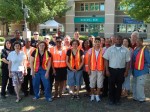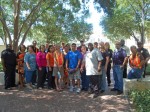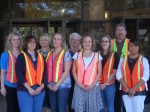They’re familiar faces around campus each day – administrators, technicians, computer lab support – typically working on their own daily duties. However, when an emergency or disaster strikes, they’ve got another job to do – being an emergency coordinator on the campus emergency team.
In an emergency each campus has an emergency team that takes action in the hallways and at rally points, always indentified by their orange vests. They take their direction from the campus manager on the right protocol based on ACC emergency procedures. They’ve been through the training and know what needs to be done – they can reassure students, faculty, and staff when stressful conditions arise.
“I feel a responsibility to the building and know how to remain calm in an emergency,” says Terry Arzola, instructional design specialist and part of the emergency team at the South Austin Campus (SAC). “I want to be the difference, in terms of making people feel safe in the situation. It’s always a matter of knowing what to do.”
The emergency team members are equipped with two-way radios, whistles, and flashlights. The campus manager or administrator-in-charge also wears an orange hat. Each member of the team experiences a variety of situations through training, scenarios, and drills.
Whether it’s a building fire or weather emergency, an important factor during any situation is communication.
“Not everyone interprets what is said the same way,” says Laura Tabor-Huerta, a media technology specialist and a part of the SAC emergency team. “During training each emergency team discusses what is being said and what would be said, helping ultimately with communication in a crisis.”
That’s especially true at the Pinnacle Campus where 10 floors must be covered in an emergency. Therefore, they arrange for each floor to have several emergency coordinators on the emergency team day and night.
“Being in a high-rise, there is someone on every floor to make sure everyone is prepared and communicating about what is happening,” says Melissa Brown, the campus manager administrative assistant at Pinnacle. “After all, looking out the window on the 10th we can see the clouds moving around.”
If one person really knows about weather, it’s Marc Petrick at Cypress Creek, who has been an emergency coordinator there for seven years. Petrick is a senior computer lab support technician, but also is a certified SkyWarn tracker. He knows exactly what to look for in the clouds, which is especially helpful in Cedar Park where tornados have been known to touch down.
“I’ve been here at night when we had to respond to tornado warnings,” says Petrick. “It’s just important to act calmly and guide everyone to the safer areas of the building – as a part of the team you have to keep your demeanor.”
While the campus emergency teams are there for assistance and communication, it’s important that each person be responsible for his or her own safety. From Sept. 6-9, ACC will conduct an Emergency Preparedness Week to educate students, faculty, and staff regarding how they can protect themselves in the event of an emergency.
One important step to take now is to sign up for ACC Emergency Alert. In the event of a serious emergency, the ACC Emergency Alert system can send critical voice and text messages to your cellphone. For more information and to sign up for ACC Emergency Alert, visit the Emergency website.
Six Ways ACC Communicates in an Emergency. Click Here to View
Back to Top










